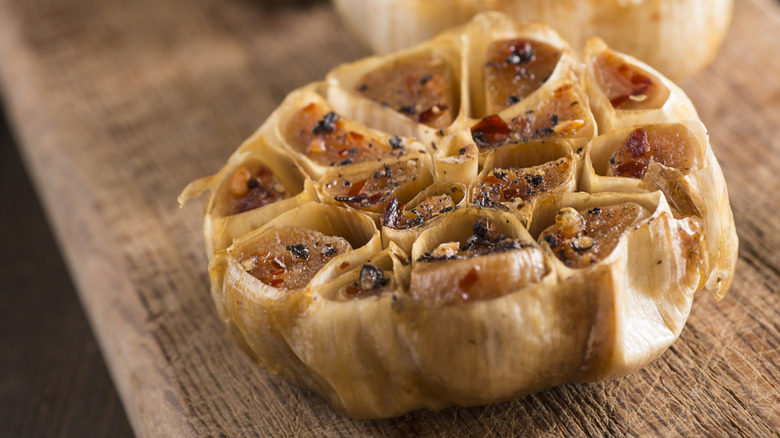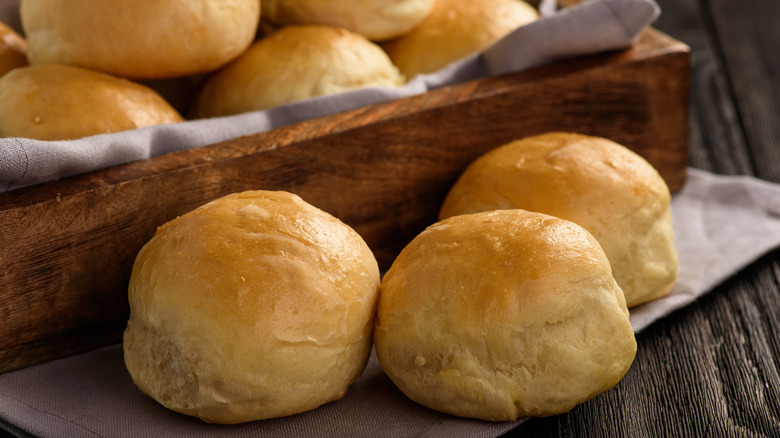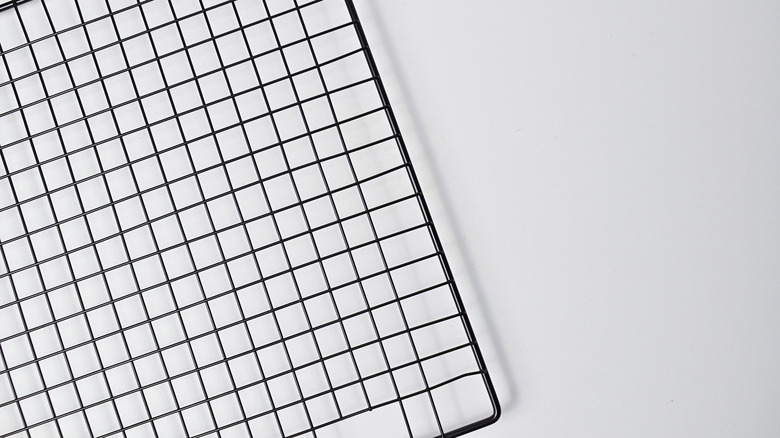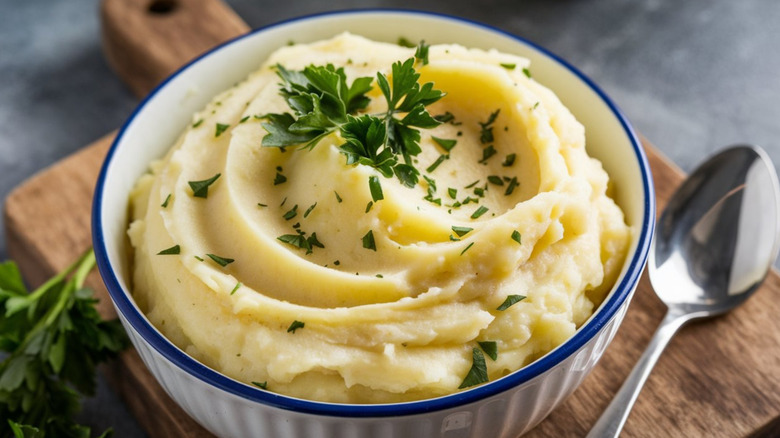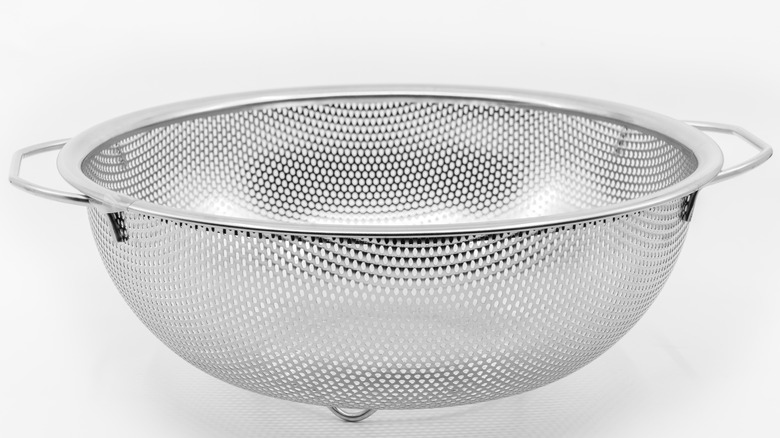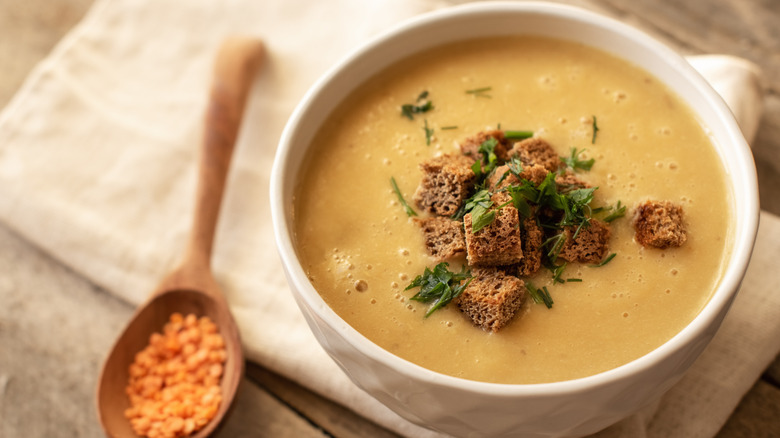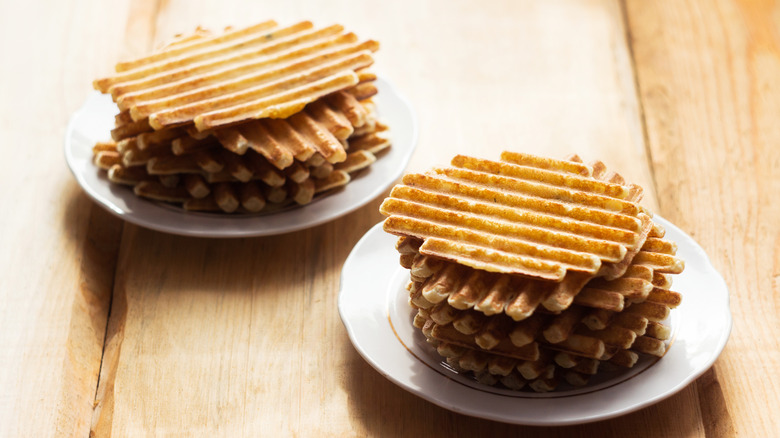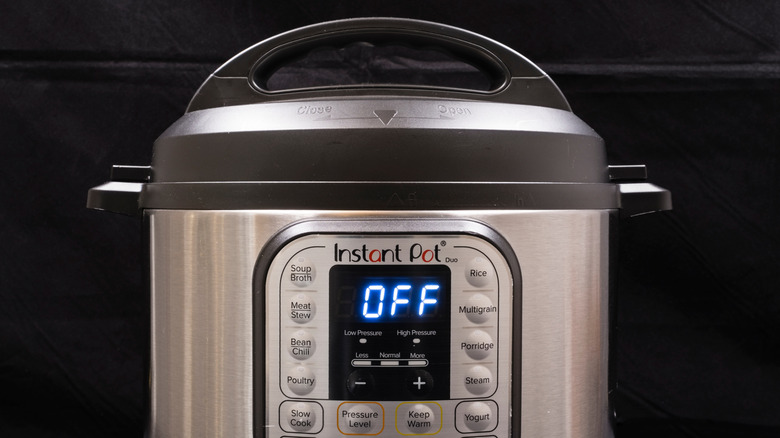9 Mashed Potato Hacks You'll Want To Try Right Now
Just because something is a staple side dish doesn't necessarily mean it's simple to make. Mashed potatoes are somehow both a special occasion food and a typical side dish to weekday dinners. However, there is some nuance that goes into making it — whether it be for dinner on Thanksgiving or any given Tuesday.
When making mashed potatoes, it takes several steps to turn a hard root vegetable into a creamy and flavorful side dish. The typical procedure involves peeling, chopping, boiling, draining, and of course, mashing. However, there are some shortcuts that you can take that will leave you with just as satisfying results. You might be surprised with how few ingredients and kitchen tools you actually need to make mashed potatoes.
Once you are finished enjoying your mashed potatoes with dinner, it's not uncommon to have a few servings of leftovers. While you can always just try to enjoy your dinner for a second time the next day, sometimes it just doesn't hit the same after it has been sitting in the fridge.
Luckily, leftover mashed potatoes are a very useful ingredient to have in the kitchen and can be used to upgrade a variety of dishes — such as thickening soup. You can also turn your leftovers into a crispy treat by frying them. Since mashed potatoes are so versatile, you have a lot of options outside of just heating them up in the microwave. Next time mashed potatoes are on the menu, try these simple hacks to make your life a little easier.
Roast garlic inside the potato before mashing
One of the most common upgrades to mashed potatoes is garlic. Its bold flavor pairs well with the creaminess of the potatoes. When incorporating any add-in to mashed potatoes, flavor can be introduced during many stages of the process. To bring garlic into the equation as early as possible, try roasting the garlic inside the potato before you move on to the mashing stage.
By utilizing your oven, you can soften your potatoes and garlic without having to boil them. This approach will give you time to prepare the rest of your meal while you wait for the timer to go off.
To do this, prepare your potatoes for the oven by cleaning them and slicing them down the middle, but not all the way. Next, add a whole garlic clove to the inside of each potato. As your potatoes and garlic roast, the flavors will have the opportunity to blend as they become tender enough to mash. Once they are ready to take out of the oven, you can fully combine the flavors by mashing the roasted garlic cloves into the potatoes.
While whole cloves of garlic may seem daunting, roasted garlic cloves do not bring as strong of a flavor to a dish as crushed garlic or other varieties might. This is because when garlic is cut, it triggers a reaction between its molecules, which does not occur if it is roasted first. Roasted garlic adds a certain depth of flavor that is sweeter than when served raw. So, if you were looking for that strong kick of garlic, you might want to stick to just mashing in crushed garlic.
Substitute mashed potatoes for potato flour in bread
It is always noticeable when a cook takes the time to bake bread from scratch rather than pick up something at the store. Adding mashed potatoes to your homemade bread is an easy way to impress your guests with your baking skills — even if you just use leftovers.
When making bread, you have many options on what kind of dough to make. If you are looking for a fluffy roll to pair with your meal, a potato roll is always going to deliver. The origin of potato bread goes back to the 18th century when a French pharmacist and agronomist made it while experimenting with different recipes that use potatoes. At this time, potatoes were being promoted as cheap sources of nutrients in food. Instead of using only wheat flour, it was discovered that potatoes could be used to supplement the wheat flour in the dough. Not only did they find that this was a cost-efficient option, but they also found that adding potato gives the bread a desirable texture.
Usually, modern potato rolls and loaves use potato flour. However, you can swap out the potato flour with mashed potatoes for an extra moist result. When you substitute mashed potatoes for potato flour, you are still getting all of the benefits of the starchy potato, but you are also getting the added dairy (if you choose to use milk) and seasonings in your dough for an upgraded flavor.
For this hack, you can use leftovers or make them specifically to make bread out of. If you use leftovers, just make sure you adjust the other seasonings in your dough accordingly. Otherwise, you might end up with a very salty roll.
Replace your potato peeler with a baking rack
One of the most tedious parts of making mashed potatoes is also one of the first steps: peeling the potatoes. With a simple hack popularized by LORAfied on TikTok, you can knock out both peeling and mashing the potatoes in one step.
When you think about the kitchen tools you need to make mashed potatoes, you might think of the obvious: pot, potato peeler, ricer, or potato masher. Those are all useful in their own ways, but there is something to be said about a versatile kitchen tool that has a variety of uses — like a baking rack.
In between cooling cookies, your baking rack sits flat in your cabinet, waiting to be used. What many do not consider is the role its sturdy gridlike design could play in preparing mashed potatoes. When incorporating a baking rack in your mashed potato-making process, you can skip the peeling step and boil the potato with the skins still on. This is because the baking rack is going to take care of the skins for you.
Next, you are going to want to drain them and let them sit until you are comfortable handling them. Slice the potatoes in half and press the insides through a baking rack and into a bowl. From here, you can carry on with seasoning your mashed potatoes however you would like.
Serve them cold
When you think of mashed potatoes, you might think of a steamy bowl of hot and creamy potatoes topped with butter. This is probably the most popular way to serve mashed potatoes, however, it is not the only way.
Mashed potatoes do not need to be served hot, but, when served cold, it is sometimes considered a form of "potato salad." While it may share some of its core flavors, the consistency of this dish will be nothing like the potato salad you might be used to.
Traditional potato salad usually consists of chunks of potatoes mixed with chunks of celery and eggs, held together by mayonnaise, mustard, and seasonings. This variation of potato salad will be creamy, however, you can choose to keep some chunks in your mashed potatoes if that is what you prefer.
When preparing this dish, you follow the same steps that you would if you were to serve it hot. Once the potatoes are at the desired consistency, you can start to add your mix-ins and stick it in the refrigerator until you are ready to enjoy.
Experiment with this cold dish by combining your leftovers with ample seasonings, condiments, and toppings. You can add traditional potato salad seasonings, such as celery salt and garlic powder, or you can mix it up with other spices that match the vibe of your meal.
Mash your potatoes with a colander
If mashed potatoes are not something you make all the time, you might not have a potato masher or ricer on hand. If all of a sudden you are craving some homemade mashed potatoes, there is no need to run to the store to buy a new kitchen tool. You might be able to use something that you already have.
You likely have a colander on hand if you eat fruit and vegetables. However, this versatile tool is good for more than just rinsing produce and draining pasta. You can use it instead of a potato masher or ricer. A colander's many holes make it a great candidate for perfecting the creamy texture of mashed potatoes.
If you opt to use a colander for the mashing part of the process, you can precede this step with business as usual — peeling, chopping, boiling, and draining. Once your potatoes are properly prepped, simply push the potatoes through the holes of the colander and into a large bowl. This will replicate the similar effect of a potato masher or ricer.
While this hack is convenient for those who do not own typical mashed potato-making equipment, it might take a little extra effort than a potato masher or ricer might. Pushing the boiled potatoes through the holes of a colander is definitely possible, you just might have to apply extra pressure as you push it through. Using a spatula can help make this process a little easier.
Taking advantage of a multi-use kitchen tool — such as a colander — is a great way to save precious kitchen space. When it comes to mashing potatoes, what matters is that it gets mashed to the intended texture. No one is going to ask you what kitchen utensil you used to get it there.
Thicken soup with mashed potatoes
When the weather calls for soup season, it is time for thick and creamy soups to replace the summer's light and brothy bowls. When you are craving a nice and thick soup, you have several options when it comes to choosing a thickening agent — popular ones being cream and flour. However, if you use up your leftover mashed potatoes to thicken your soup, you won't have to buy any extra ingredients.
If you already have the potatoes made from the night before, it might actually be an easier thickening technique than using flour or cornstarch since you do not have to worry about properly combining them. When adding mashed potatoes to soup, all you have to do is plop it in and stir it until combined.
It is best to add in your potatoes one scoop at a time so that you have the chance to customize the consistency. If you want a really thick soup, then you can pile on the potatoes, but if you are judy looking to add a little extra creaminess, then one scoop might do the job.
Crisp up your leftovers
After a delicious dinner the night before, it is tempting to attempt to recreate the magic the next day with reheated mashed potatoes. It seems easy enough to just put them in a microwave and enjoy, however, it's never the same as it was when it was fresh. Instead of trying to keep mashed potatoes in their original form, try turning them into something new.
One of the best ways to enjoy day-two potatoes is by adding a little crunch. Now, there is not just one way to do this. Technically, the easiest route would be to throw some butter on a pan with your leftovers and fry until crispy. However, with a little bit more effort, you can create a more adventurous dish.
Croquettes are a seemingly fancy dish that you can whip up easily if you have already made the mashed potatoes base. All you need then is your seasonings of choice, breadcrumbs, and egg. You also might want some sort of aioli or sauce to dip it in.
Or, let your leftovers take on a new shape by putting them in a waffle maker. Make potato cakes by adding egg, seasonings, flour and maybe a little cheese to your leftovers and put it in a waffle maker. This will create a crispy exterior that is perfect for brunch or dinner. When you consider the existence of waffle fries, putting mashed potatoes in a waffle maker might not seem so unusual.
When you are crisping up your leftover mashed potatoes, do not be afraid to throw in some flavorful add-ins such as bacon, onion, garlic, or whatever you can find in your kitchen.
Use potato water to make thicker mashed potatoes
When cooking mashed potatoes, something as simple as the type of liquid you use can make a big difference in the consistency and flavor. Usually, mashed potato recipes call for milk or another dairy product to achieve a creamy consistency. However, if you don't already have something in the fridge, you don't necessarily need to buy extra ingredients to thicken your mashed potatoes. By using potato water, you can save money on groceries and even make your mashed potatoes vegan if you leave out the butter as well.
There is no secret to making potato water since it is just the water leftover from boiling potatoes. However, it is what you do with the water that matters. Once you take your spuds out of the pot, you are left with a mixture of potato starch and water. This starchy water might have a milky consistency that should reassure you of its ability to be a milk substitute.
Using potato water is basically free since you are just using the water left over in the pot after boiling. Instead of dumping it down the drain, you can use this water to enhance your mashed potatoes and make them thick without adding any dairy. This is a win for anyone who follows a dairy-free diet.
In addition to being a dairy substitute, potato water can also be used later on to rescue runny potatoes. Potato water's thickening powers can easily correct whatever mistake happened to make your dish runny. All you have to do is add the potato water in small increments until you get the consistency you want.
Use a slow cooker
Technically, the traditional boiling method is the quickest way to make mashed potatoes. However, it requires a lot of attention to make sure your pot doesn't boil over.
Instead of tending to your potatoes while they boil, you can use a slow cooker to make creamy mashed potatoes. The nice thing about a slow cooker is you can have food cooking in it all day while you work, clean, or do anything except stand over a boiling pot. You can even set it on low and leave the house for a few hours while it cooks. Since this process takes a while, this is not the best method for last-minute meals.
All you have to do is put your chopped potatoes in your slow cooker with your cooking liquid and seasonings. It will likely take four to five hours for the potatoes to be tender enough to mash. Once they are ready, you can mash them right in the slow cooker. Just be careful not to burn yourself. This trick is not only efficient, but it saves you the hassle of extra dishes.
When using a slow cooker, you want to make sure that each cube of potato is roughly the same size so that it all cooks at the same pace. If your mashed potatoes get done before the rest of the meal, that is not a problem. Once your mashed potatoes are made, they will remain safe to eat as long as it is in the slow cooker and it is on.

